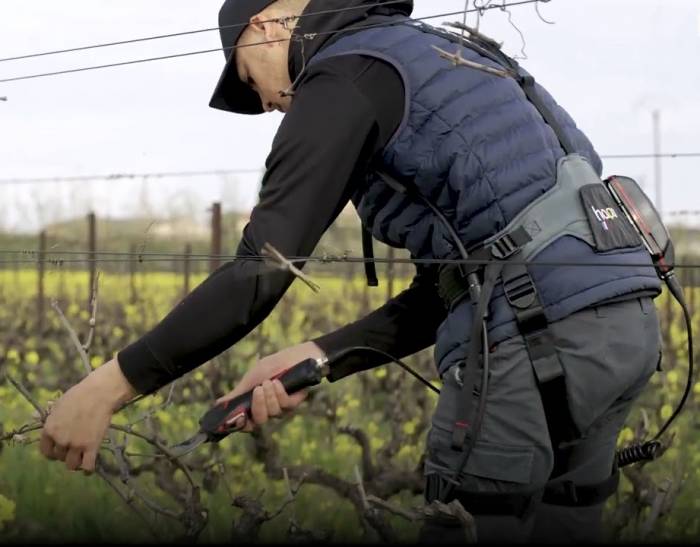Exoskeletons Cut Vineyard Workers’ Back Muscle Strain by Up to 30 Percent in French Study
Relief most notable in low vineyards, but high dropout rates and shifting strain to legs raise questions about long-term benefits
2025-11-19

Between 2022 and 2025, a study in the Languedoc region of southern France examined the impact of exoskeletons on vineyard workers, particularly those involved in pruning vines. The research was initiated by the MSA Languedoc, a social security organization for agricultural workers, in response to increasing requests for advice and funding related to these devices. The study was conducted by two ergonomists from Ergogenèse, a consulting firm specializing in ergonomics.
A total of 33 vineyard workers, ranging in age from 18 to 65, participated in the trial. They tested three different passive exoskeleton models: the LiftSuit (0.9 kg), the Hapo (1.1 kg), and the Exoviti (2.2 kg). These devices are designed to assist the back using elastic bands or springs that provide support when the wearer bends forward and help them return to an upright position with less strain on their back.
To measure the effects of the exoskeletons, researchers equipped each participant with seventeen motion sensors placed on various joints, including wrists, elbows, shoulders, back, neck, knees, and ankles. Each worker performed pruning tasks for 20 minutes with an exoskeleton and another 20 minutes without one.
The results showed that exoskeletons had little to no effect when used in high vineyards, where workers do not need to bend as much. The posture required for cutting branches at heights above 70 centimeters did not change significantly with or without the device. However, in low vineyards where workers must bend more deeply, the benefits were clear. The exoskeletons provided noticeable relief by reducing the effort required from the back muscles.
Some participants reported immediate relief from back pain. One grower who was close to retirement reconsidered his decision to leave his job after experiencing significant comfort while using an exoskeleton. Others noted reduced soreness and fatigue at the start of the pruning season when their bodies were not yet accustomed to the physical demands.
Further analysis included measurements of muscle activity and heart rate during work with and without exoskeletons. The data indicated a reduction in back muscle activity by 5% to 30%, with a corresponding increase in thigh muscle use. This shift means that while pressure on the back is lessened, more strain is placed on the legs. No significant changes were observed in heart rate.
Despite these positive findings for some users, only 14 out of the original 33 participants completed the full trial period. Many dropped out due to discomfort, difficulty adjusting the devices, lack of perceived benefit, or changes in employment. Among those who continued, preferences varied: some favored lighter models like LiftSuit for their versatility and comfort during driving or tractor work; others preferred Exoviti for its stronger support but found it less convenient for tasks requiring frequent vehicle use.
The MSA Languedoc provided these exoskeletons free of charge to participants who wished to keep using them after the study ended. However, experts caution that exoskeletons are not a cure-all for back pain. There is concern that reduced use of back muscles could lead to muscle weakening over time. Additionally, shifting strain to other joints such as hips, knees, and ankles could introduce new risks that have not yet been fully studied.
The cost of these devices—ranging from €1,200 to €1,800—also limits widespread adoption among vineyard workers. Sales have not met initial expectations. Still, some see value in occasional use during particularly demanding periods or as a tool to attract new workers at a time when labor shortages are common in viticulture.
According to Éric Argolias, a risk prevention advisor at MSA Languedoc’s occupational health service, exoskeletons may also be useful for other vineyard tasks such as tying canes or manual harvesting if accepted by growers. He recommends medical consultation and thorough testing before purchase since there are no comprehensive scientific studies outlining contraindications for use. During this experiment, individuals with heart problems, problematic hernias, skin conditions at contact points, balance or coordination disorders, and pregnant women were excluded from participation.
The study highlights both potential benefits and limitations of exoskeletons in vineyard work. While they can provide relief for certain tasks—especially in low vineyards—they are not suitable for everyone or every situation. Ongoing research aims to better understand their long-term effects on worker health and productivity.
Founded in 2007, Vinetur® is a registered trademark of VGSC S.L. with a long history in the wine industry.
VGSC, S.L. with VAT number B70255591 is a spanish company legally registered in the Commercial Register of the city of Santiago de Compostela, with registration number: Bulletin 181, Reference 356049 in Volume 13, Page 107, Section 6, Sheet 45028, Entry 2.
Email: [email protected]
Headquarters and offices located in Vilagarcia de Arousa, Spain.